There’s nothing like anchoring your floating home in a unique culture’s “neighborhood” and literally living in that neighborhood for however long you choose to stay. Cruisers experience culture differently than most other travelers. We get to actually LIVE there and if we choose, get to know the people, their neighborhood, their culture. It’s a privilege and an honor! But appreciating it makes most cruisers want to give back to the communities they experience, but how?
Living on our sailboat, Winterlude, in the Western Caribbean six months a year we’ve been lucky enough to experience different neighborhoods from the tip of the Yucatan to Cartagena, Colombia. Our favorite, the Kuna culture of Panama was reinforced by our first experience anchoring beside the easternmost isolated traditional village, Anachucana. Unlike modern day indigenous cultures, the Kuna’s relative isolation has allowed them to preserve their culture and traditions far beyond similar cultures. Unfortunately, those days are quickly drawing to a close with the construction of a path, now a 4 wheel drive “road”, over the Darien jungle mountains to Panama City. Prior to the “road” the only physical access was via boat or airplane. The inevitable invasion of satellite television and cell phones also contributes to the cultural erosion.
Tips for Experiencing Local Culture
 1. Learn a bit about the history of where you’re going so you can appreciate it more. No matter where you’re going, you can educate yourself more – the library is good, buying books – even out of print books like I found with the Kuna of Panama – “A People Who Would Not Kneel” — you can’t appreciate how hard the Kuna have worked to keep their culture until you read this book. I found it on Abe Books or one of the out of print booksellers – just google out of print books or used books online if you’re trying to find an out of print book about an area you’ll be cruising.
1. Learn a bit about the history of where you’re going so you can appreciate it more. No matter where you’re going, you can educate yourself more – the library is good, buying books – even out of print books like I found with the Kuna of Panama – “A People Who Would Not Kneel” — you can’t appreciate how hard the Kuna have worked to keep their culture until you read this book. I found it on Abe Books or one of the out of print booksellers – just google out of print books or used books online if you’re trying to find an out of print book about an area you’ll be cruising.

2. Learn a bit of the language and try to interact with the locals. In this case, the San Blas Islands, known to their inhabitants as Kuna Yala, the official language is Kuna. Only in the past few years when the Panamanian government intruded into their lives to insist upon building schools have the younger children begun learning Spanish. We put together index cards with some key Kuna words to try and use their language rather than just our Spanish. They appreciated the gesture and we had ALOT of fun interacting with the children who inevitably looked at our little “cheat sheet” language card, laughing and then loved helping us learn proper pronunciation, or even the correct words to say what we were trying to communicate. What FUN!!!

3. Give back! In some cases, cruisers represent a lifestyle unknown (and possibly undesired) by the locals. But we can be ambassadors by offering useful things that may not be easily available — we chose reading glasses for the Kuna women. Kuna women are famous for their unbelievable tiny perfect stitching in a traditional art called mola making. Molas were originally used for women’s clothing, but they are rapidly becoming prized as works of art due to the intracacy of the stitching. Since in many villages there is no electricity, the stitching must be done by firelight in a dimly lit wooden hut. I don’t know about you but I can’t see to read a book, much less make perfect stitches almost smaller than detectable by the human eye in some cases! So we thought giving them reading glasses would be a good plan. Unfortunately, the men still dominate the culture and we found out very quickly that the elders in the tribe (usually male) ALSO needed reading glasses. So the next year we brought more until we were known as the “len sus” boat – a young man – maybe all of six years old – paddled his grandmother out to our anchored boat in their wooden dugout. As they approached, the young man would call out “len sus” “len sus” and we’d get out of baggies full of reading glasses and help the older woman pick out a pair that worked for her. It would be immediately apparent which strength was working from the ear to ear grin on her face! Wow, I wish we could go back and do it all over again….
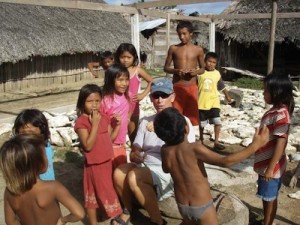
4. Everyone wants to give something to the adorable children, but we do them no favors by giving candy or other sweets – their teeth are bad enough with soda and other outside world intrusions. Instead we choose to give fun things they may not have seen before – leftover wedding bubbles were perfectly sized and provided hours and hours of interaction with the Kuna children. We also liked giving foam glider airplanes to the boys and play-doh, or crayons/markers and paper/coloring books. We donated our english/spanish dictionary to a family particularly interested in advancing their language skills.
5. We were asked to write and construct a photo/writeup project for an Kuna entrepreneur showing types of boat work he could do and adding cruiser recommendations from those that came before. He would use the flip book to illustrate to future cruisers his abilities to gain further gainful employment.
6. In settlements with no electricity, we were asked a few times to charge villager’s cell phones and even portable DVD players. I was a bit put out after the second day of charging literally 26 cell phones and the same DVD player over and over. But it turned out that the DVD player was passed from family compound to family compound – each night a different family enclave would enjoy whatever movie they were passing around. Turned out that the school teacher had a Honda 2000 generator and when he was on the island, he would charge them $1. But school was out and the teacher was off on vacation, hence no charging capabilities … other than the two cruising sailboats that happened to anchor off the island about the same time. 🙂
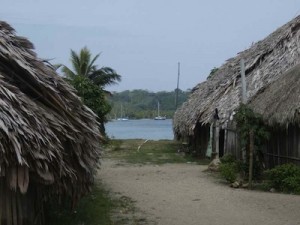
4. Volunteer for a project – often cruisers initiate projects such as painting a school or helping construct it, helping raise money to pay for a teacher, helping coordinate bring donated textbooks — or medications — to a new medical clinic or school. If you’re in an area long enough and you get to know what might be helpful to your new friends, consider helping to initiate a cruiser project. Get other cruisers to help by donating supplies, funding and manpower. You will never regret the time allocated to these types of projects.
5. Some cruisers we know had a Christmas toy and food drive for locals — keep in mind, many cultures don’t celebrate the same holidays as we do, but they may enjoy experiencing what some of our traditions are like — like the time we planned a Super Bowl Party in the San Blas – one of the more progressive villages had electricity and even a television. They moved the TV outside, the cruisers provided all the food, drink and shared the Super Bowl party experience with as many curious Kuna locals as wanted to attend.

Whatever you do, enjoy the neighborhoods you’re privileged to temporarily move into and remember to enhance your own enjoyment of the experience by working to learn a bit of the language, interact with the locals and give back. Do you have other experiences to share with good ways to give back to the cultures and communities we are so lucky to be able to visit? Please leave a comment and share! THANKS! Jan

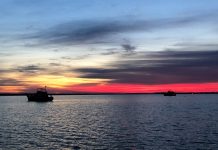
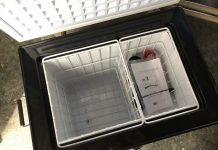








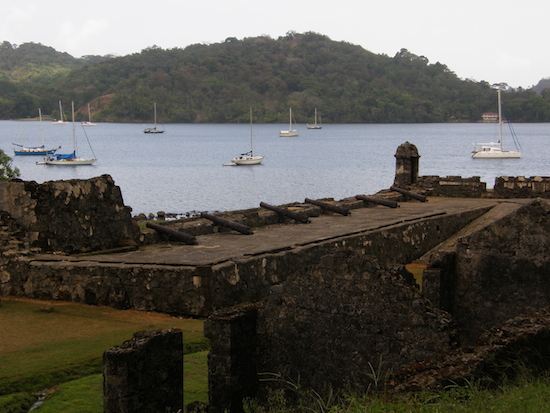


Just picked up my copy of the boat galley cook book. Guess what I’m doing…..
🙂 Taking a photo to submit to my commuterCRUISER.com Boat Galley Cookbook photo submission? Carolyn & I want to see where The Boat Galley Cookbook is traveling, so be sure to go to the site & upload a photo with you, or your galley or a local landmark, whatever! 🙂 ENJOY! We hope you enjoy many tasty meals with the cookbook! Cheers! J
Jan – lots of great ideas here – thank you! I linked to your post here: http://themonkeysfist.blogspot.com/2013/07/volunteer-opportunities-for-cruisers.html
Thanks Ean & Jane! I loved your post combining lots of resources for volunteer opportunities & culture on http://themonkeyfist.blogspot.com! Cheers! Jan